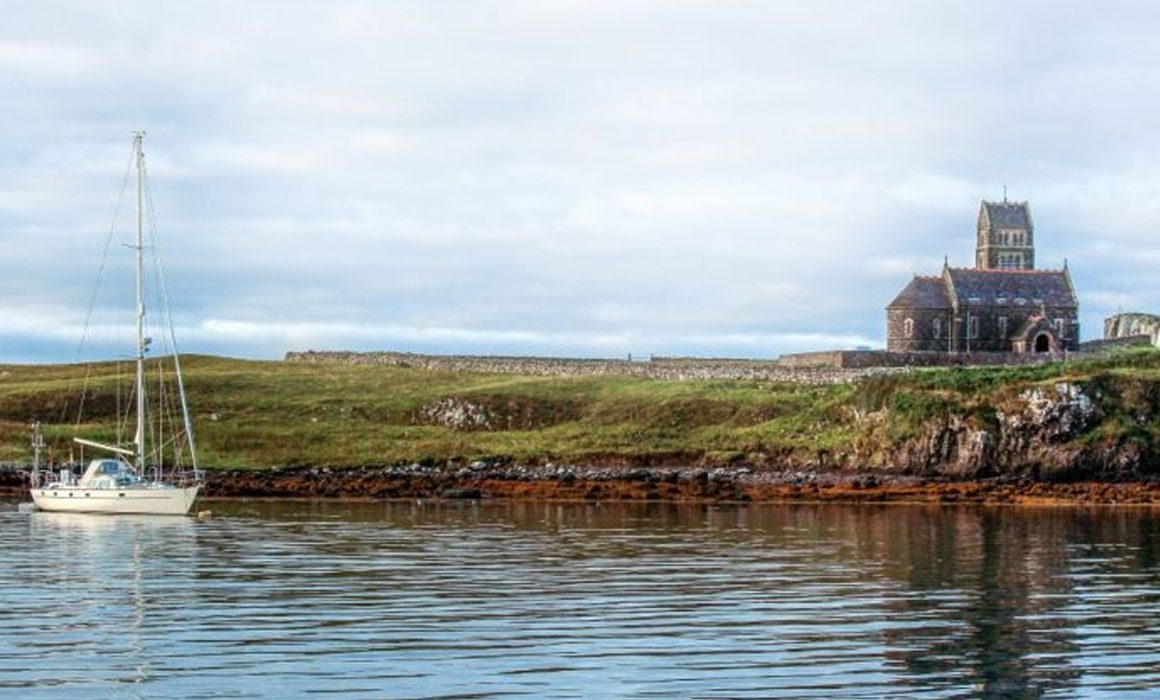

Northerly winds dictated the route of our week’s cruise around the Inner Hebrides, so with full sail on Aisling – our Contessa 32 – we headed south along the rock-strewn coasts of Skye. Atlantic gales bring powerful seas and winds to this west-facing coast of Scotland so cruising sailors have to be hardy and cautious – which explains why there are so few, writes Kevin Green.
There are many variables about west coast sailing but there is one constant: rain. Often arriving horizontally but then again often innocuously persistent and even pleasantly warm thanks to the Gulf Stream. Our cruise brought all the classic weather ingredients – two gales, heavy rain, stunningly clear sunshine and, thankfully, only neap tides.

“You can tell it’s very windy because the rubber dinghy flies behind the boat,” observed my chum Ronan who’s been flying his dinghy off Aisling’s stern for 15 years. She is reputedly one of the few yachts to finish the disastrous ‘79 Fastnet Race that drowned 21 sailors and sunk 23 boats.
Her main features are a thick, keel-stepped mast, deep semi-long keel and a near-50% ballast ratio – a well-equipped vessel for the dreaded Minch, one of the stormiest waterways in Europe that lies between the Inner and Outer Hebrides. As a child I’d crossed it on family holidays and watched in amusement as passengers’ hats flew off from the Calmac ferry, fluttering among the gannets that streaked past in the stiff breeze.
As we approached the south coast of Skye we tucked in a reef – just in case. Passing the MacDonald stronghold at Armadale Castle (now the famous Clan Donald Cultural Centre), we discussed the two rival clans that ran Skye, the MacDonalds and the MacCleods. They often crossed claymores once the Vikings had retreated.
Descended from them, the early MacDonalds were part of the famous Lord of the Isles dynasty that ruled after the Vikings left in the 13th century.
Skye played many parts in history, including being the home of Flora MacDonald who took the defeated Prince Charles Edward Stuart over to the island after the English defeated Scotland’s best at Culloden in 1746.

Flora and the largely Highland army were to suffer more afterwards in what became the dismantling of Highland culture and the clan system.
The wearing of the plaid was banned, as was the playing of the pipes. But worst of all was the outlawing of our language, the Gaelic. So despite growing up in a Gaelic-speaking household I was not encouraged to speak it.
RING OF BRIGHT WATER
History lies heavily in the Highlands but there is plenty of it to choose from, as we’d found out at our first anchorage. Sailing into the mainland bay of Sandaig we visited the former home of Ring of Bright Water author Gavin Maxwell. The colourful aristocrat had leased a house here and used the burn for his beloved otters. Weirdly, before his ‘epiphany-to-wildlife-saviour’ he’d decimated the local basking shark population – it never recovered.
Looking west from Sandaig the stupendous views encompassed a horizon filled with islands – the Small Isles. Shelter is never far on the west coast, thanks to the large majority of Scotland’s nearly 800 islands being on this seaboard.
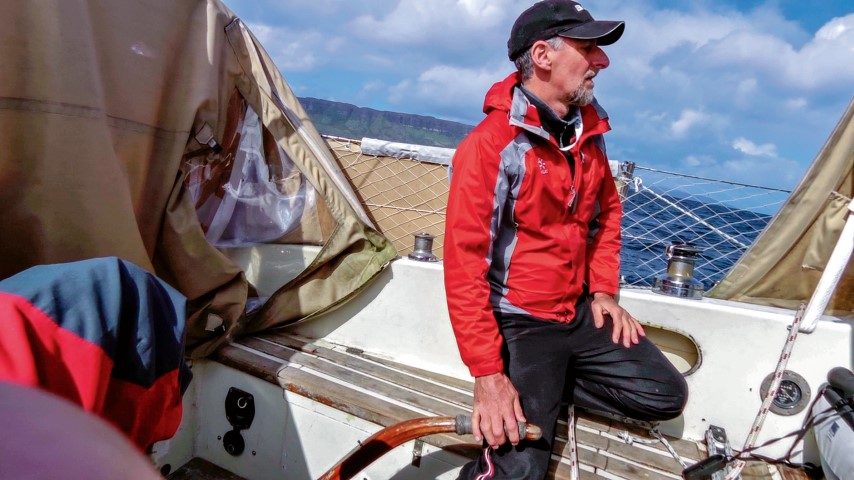
The Stornoway Coastguard VHF forecast warned of westerly gales so we headed for an anchorage to ride them out. It lay on the low-lying island of Canna, described in the Clyde Cruising Club’s Sailing Directions as an excellent anchorage and sheltered from all directions.
Obscuring it were the brooding mountains of Rhum and dotted around its shores were fish farms; one of the modern success stories of this region. Looking east, the towering peaks of the Cuillins, some of the highest mountains on the west coast, jutted out from Skye.
Reefing the big genoa as we rounded the north point of Rhum we saw another reminder of the weather – the 2011 wreck of a large French stern trawler – the Jack Abry II – she seemed to be berthed against the high cliffs.
The green and verdant Canna lay low and its wide bay looked welcoming as we glided in. A grey seal swam over and snorted at us while a flock of geese honked overhead. Also welcoming were the plentiful, government-supplied moorings.
Stillness descended as we sat in the cockpit, celebrating with a dram from Skye’s Talisker distillery. I studied the few buildings: the nearby small stone church, the farm steading, and on the smaller island of Sanday a grand neo-Romanesque church. This was now the archives for Gaelic writing, established by the benevolent last owner, John Lorne Campbell and his American wife Margaret Fay Shaw.
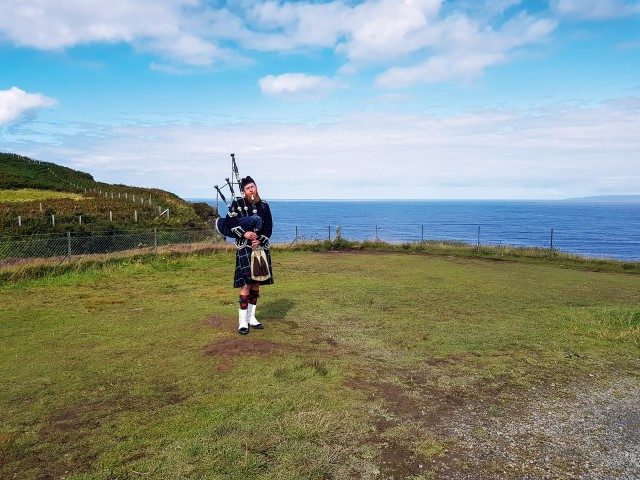
An accomplished photographer, his wife has left 1,000 negative photos of life in the west Highlands. These are being digitised and will complement the extensive written archives gleaned by her husband in a lifetime devoted to supporting Gaelic culture. Canna now belongs to the National Trust for Scotland.
It helps having friends with connections, and my mate Ronan – a well-known and travelled musician – knew many people among the isles, including the famous singer Fiona J. Mackenzie who we visited the next day in the Campbell’s grand house. She told us about her archival work and the struggle since the 2017 closure of the school that reduced island numbers to only 14 people.
VIKINGS AND PRIESTS
Waves of history passed through this arable land including religious proselytisers who displaced the druids of the Pictish nation with St Columba’s Catholic priests in the seventh century. After the Norsemen slaughtered all of them, longships were berthed here for 500 years.
Their remains are difficult to find but modern lasers and aerial radiography is revealing much, including the 2017 find of a Viking boatyard across the water in western Skye. Today Canna remains Catholic but has a Protestant church dating from 1914, as well as a new style accommodation for backpackers; small huts called ‘pods’ that have proliferated throughout the Highlands recently.

Back aboard Aisling we sheltered from the gale under the cockpit tent and ate our sausage hotpot, snug beside the diesel heater. The horizontal rain even drove the herd of Highland cattle into the rowan trees for shelter.
A day later – under full sail – the 2,500-foot peaks of Rhum loomed over us. Named in Gaelic as mountain of the troll (Trollaval), the middle peak alluded to the island’s dark history. Like many Scottish islands, Rhum had suffered at the hands of eccentric foreign owners who removed many people during the dark times of the 19th century Highland Clearances – and then used the island as a play park.
The last of these rogues was Sir George Bulloch who spent three weeks annually on Rhum after building the stately home of Kinloch Castle and filling it with exotic artefacts. As we passed the island’s dark and empty landscape, with only the rubble of houses left, it told its own sad story.

Many displaced people were forcefully shipped to America – and Nova Scotia in particular – where Gaelic communities flourish and the old working songs are still sung and popularised by authors such as Canadian Alistair MacCleod.
Rhum was eventually bought back by the Scottish government in the 1957 and wildlife is now the main benefactor of this wasteland. We saw sea eagles gliding past and my binoculars picked out deer near the tree line just above the main anchorage at Loch Scresort.
Aisling felt the full force of the Atlantic south of Rhum, as we neared the lower-lying Eigg, its Sgurr (‘buck tooth’ in Gaelic) giving it the shape of an upturned fin keeler. The rocky Sgurr towers over arable fields and as we rounded the south east corner the small haven of Galmisdale came into view.
We considered seeking out the famous Massacre Cave where the MacCleods had burned all the islanders and our talk grew maudlin as we discussed how the MacCleods’ ascendency was assured after fighting on the winning English side in the 1776 battle of Culloden.
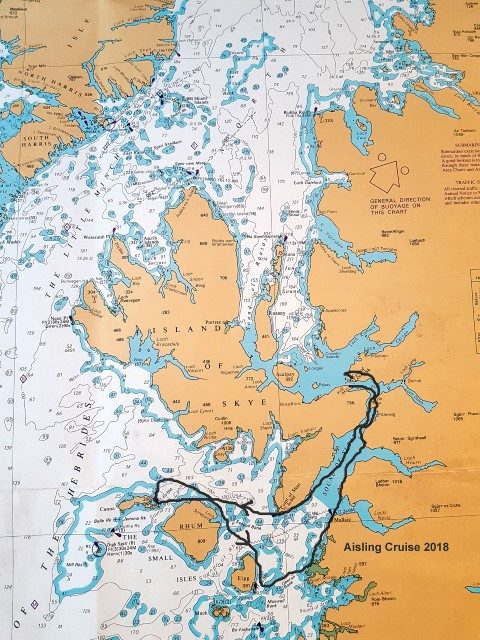
Feeling very glum we sought the Laig brewery – run by Ronan’s mate Gabe. Perched high on the island, the view from Gabe’s brewhouse showed the mainland peninsula of Scotland’s most westerly point at Ardnamurchan and to our north the Outer Hebrides. These islands included Lewis, the birthplace of yet another infamous MacCleod – Mary-Anne, the mother of US President Donald Trump.
CEILIDH
Despite being busy brewing for what he said was an exceptionally busy tourist season, Nova Scotian fiddler Gabe agreed to meet us at the island pub later for a ceilidh (musical soiree). So, with clanking, beer-filled rucksacks we wound our way down the island calling in at a few of the 70 residents to let them know about the ceilidh.
Eigg is world-famous for its community buyout, from what was yet another rogue landlord in 1997 and has been studied by international organisations as a model of sustainability. It now is also self-sufficient in electricity thanks to solar and wind turbines.
It relies on a vibrant community of multi-skilled people including many English folk escaping the congested south – a much friendlier invasion force than in 1746. A recent lifeline is the pier for the Calmac ro-ro ferry (despite visiting cars being forbidden) which allows produce and equipment to be landed easily.
While having a few beers at the ceilidh, Dean from Wolverhampton told me how he decided to paddle his kayak over to the island. Cold and near-penniless, he was given clothes and shelter. “That was 10 years ago and I’ve been here ever since!” Another English couple were sailing past in their bilge-keeled Maurice Griffiths Golden Hind and followed the same happy fate.
At this juncture, I should warn readers that this lifestyle involves a lot of self-sufficiency and surviving a Highland winter is indeed a badge of honour; something I can vouch for having been born in the most-northerly village in the British Isles.
OVER THE SEA TO SKYE
The following day the mighty Sgurr of Eigg was our backbearing during a roller-coaster broad reach across the Minch and then the calmer Sound of Sleat to the busiest fishing town on the west coast: Mallaig. “Gee whiz there’s traffic lights at the entrance!” I shouted back to Ronan from the bow as we dodged a fast-moving Calmac ferry Skye-bound.
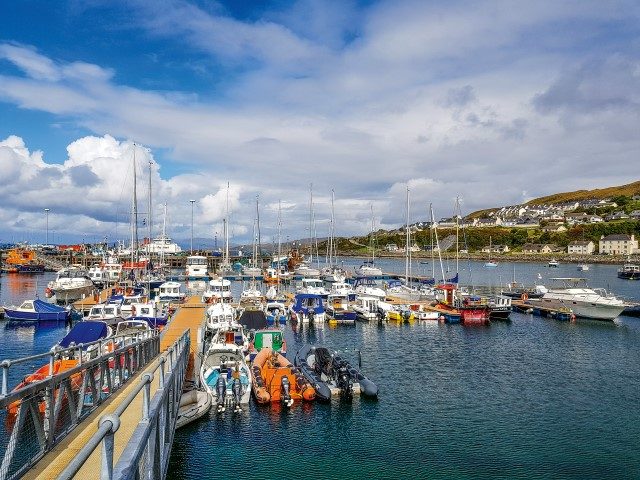
It was only about six years ago the fisherfolk of Mallaig relented to let us pesky yachties share their busy port, so now before us lay the most northerly marina on the west coast; but still exposed to the east (in case you’re thinking of wintering here). Yet more civilisation awaited in the form of the French style boulangerie and lots of what I call tartan-trock shops clustered around the station where the Hogwarts steam express from Glasgow was decanting Harry Potter fans.
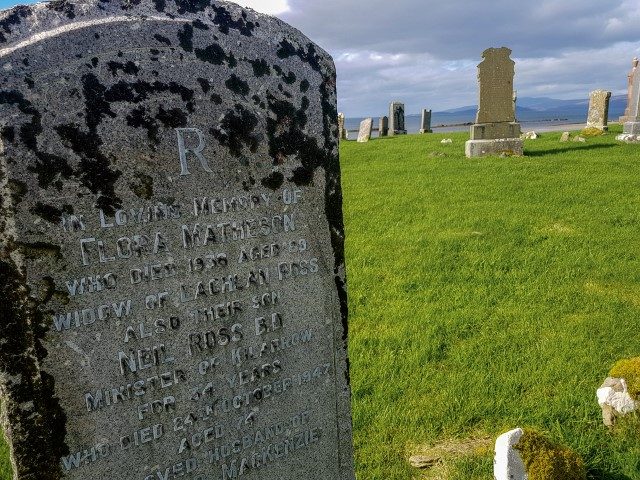
Ducking into the nearby Fisherman’s Mission to escape the throng we had the best haddock and chips in years. As is the west coast way, the weather had changed to solid rain by then so a sprint to the nearest hostelry brought us to the Marine Bar where we downed some Tennents Lager while yarning with some fishermen.
Our stroll back to the marina for what was the last night of the voyage rewarded us with yet another change in the weather, as a dramatic sunset formed of towering clouds and butterscotch light over the mighty Cuillins Mountains.
As writer Gavin Maxwell quite rightly said about the Scottish west coast, many things may change but the rocks remain.




